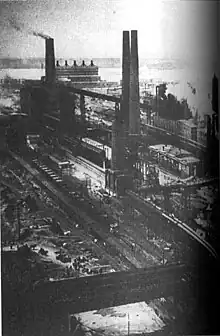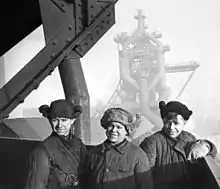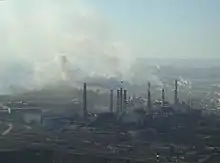Magnitogorsk Iron and Steel Works
Native name | ПАО "Магнитогорский металлургический комбинат" |
|---|---|
| Type | Public (ПAO) |
| MCX: MAGN[1] | |
| Industry | Industrial Metals & Mining (Sector)[2] |
| Headquarters | Magnitogorsk, Russia |
Key people | Pavel V Shilyaev[1] (Chairman) |
| Products | Iron & Steel (Subsector)[2] |
| Revenue | 11,869,000,000 United States dollar (2021) |
| 3,753,000,000 United States dollar (2021) | |
| 3,121,000,000 United States dollar (2021) | |
| Total assets | 9,715,000,000 United States dollar (2021) |
| Website | www.mmk.ru |
Magnitogorsk Iron and Steel Works (Russian: Магнитогорский металлургический комбинат, romanized: Magnitogorskiy Metallurgicheskiy Kombinat), abbreviated as MMK, is an iron and steel company located in the city of Magnitogorsk, Russia.[3] As of 2017, it was the 30th largest steel company in the world.[4]
History of Magnitogorsk mining
Historically, the centre of Russian iron production had been focused in the Tula region. However, in the early part of the 18th century, a shift towards developing the industrial capabilities of the Urals took place which more than doubled Russia's iron production.[5] In 1828, a series of geological surveys began as part of an effort to determine the mineral make up of the Magnitnaya Mountain and create estimates of the possible amount of iron contained under it. By the latter part of the 19th century, a small town had grown up which reported more than 10,000 residents. During this time, between 30,000 and 50,000 tons of raw iron were extracted in the area annually.[6]
Establishment of MMK
In the 1870s, most of iron ore, steel and pig iron was produced in Ukraine. In 1913, Ukraine, with its rich deposits and developed industry, accounted for 75% of iron ore production, compared to 21% in the Urals. While Ukraine remained the center of metal production, rival regions were significantly less important. It was only after the October Revolution of 1917 that the effort to expand the steel industry came to the fore.[7]

As part of Soviet leader Joseph Stalin's First Five-Year Plan for the rapid development of national industry,the government decided to sponsor a project to build the world's largest steel production complex. Initially the project was planned by the Soviets and then the American-based Arthur McKee & Company was brought into over see its construction and planning. The plan to transform Magnitogorsk into an industrial complex that would become MMK was linked to the construction of the new city of Stalinsk, which had a large supply of coal.[5][8]
While there were disagreements regarding the timetable and massive shortages of supplies, the project to build the complex broke ground in 1929 with the influx of thousands of idealistic Soviet workers. The American contractors were critical of the handling of the project and were frustrated by mismanagement and so the majority of the design ended up falling to the Soviets. Much of the failure to properly organize the construction efforts was due in part to the Soviet government's desired speed, which they deemed essential in order to meet their Five Year Plan. Additionally, there were changes in personnel who had faced removal over political concerns that emerged over loyalty to the Communist Party.[8]
In opposition to claims by the advisors from Arthur McKee & Company that the facilities were not yet ready for use, the furnaces at MMK were put into action in 1932 with the first flow of molten pig iron being produced. While this move to initiate activities at the complex was applauded by the Soviet leadership, the plant was forced to halt their production only a few days later due to the need for serious repairs in the furnaces.[7] By 1933, the plant was producing steel.[9]
World War II
MMK played an important role in the Soviet victory over Nazi Germany, being the largest steel company in the Soviet Union, and located far away from combat on the Eastern Front. The strategic concept of developing various huge modern iron and steel works deep inside the country relied on the idea that future defence of the socialist homeland was going to require huge amounts of steel, as well as places to produce iron and steel that were as safe as possible from foreign invasion and aerial bombing raids.[9]
The notion of protecting the USSR's industrial base from invasion and bombing by locating it deep in the interior was not pursued as completely during the 1930s as it might have been; what parts of it were not overrun and confiscated by the Germans were hastily moved eastward in 1941 and 1942. In 1942, the West knew that "at least one armament factory previously situated near Leningrad has arrived in Magnitogorsk lock, stock, and barrel, complete with personnel, and is already going into production using Magnitogorsk steel."[9]: 258 The extent of Western knowledge of the huge eastward shift was summed up as follows: "...Even before the outbreak of war, large electrical equipment plants were removed from White Belorussia on the German frontier and also from the Leningrad district to the Urals and Western Siberia. One such plant is reported to have been removed to Sverdlovsk during 1940 and to have been producing normally in March, 1941. Any plant except the largest smelting, steelmaking, and chemical works can be moved by railroad fairly quickly and with little damage."[9]: 262–263 [...] "Thus, while no figures will be available for some time, it is my opinion that large portions of the industrial machinery formerly located in areas now occupied by the Germans, instead of being captured by them, are already in operation a thousand or more miles east of the present front, in Stalin's Ural Stronghold."[9]: 262–263
After the attack on the USSR, on June 22, 1941, MMK obtained its first order for production of metal armor. Instructions were given to proceed to the production of blanks for live shells, and to explore the possibilities of creating specialist products for armored tanks, which required a rebuild of the production facility. The government provided a number of specialists for the development of armored steel. The factory created an Armor Bureau, which was responsible for the development of technology for the production of armored steel products. By July 23, 1941, the third hearth furnace of MMK produced its first steel output for the military.[10]

Armor sheet production at MMK in the end of 1941 exceeded its pre-war production. Simultaneously, specialized areas and workshops for the production of ammunition was improved. Hand grenades, components for missiles, and other defense products were manufactured. Magnitogorsk was converted into the major military arsenal of the country. The construction and commissioning of new production units continued. Attention was concentrated on blast furnaces No. 5 and No. 6, and this blast furnace steel became the biggest in the USSR.[11]
A number of novel techniques that enriched the theory and practice of construction were developed at the site. Owing to the completion of such a large plant and its capability to fully cycle ore to final product, the nation survived the loss of huge tracts of territory to the Germans.[12]
In 1941, though the factory was not yet completely built, child labour was already being employed at what was called the CL (Central Laboratory).[13]
During the first years of the war, about 200,000 teenagers arrived to work at the factory. They worked for 10–11 hours a day, and sometimes in extreme situations as they stayed for 10 days at a time in the factory. It is due to these children that Magnitogorsk was able to build the first tanks and aircraft, as they collected 57 million rubles to help the war front.[14]
By February 1, 1941, about 428,000 people were sent to the Chelyabinsk region to help and work at the factory and its surroundings, in order to raise necessary funds for the war effort. There was a huge housing shortage, so on August 25 the factory leadership decided to initiate a project which included the development of barracks and huts. Educational institutions and health centers with hospitals were also planned as the factory grew.[15]
Before the first hostilities in 1940, MMK was producing tanks but production was sluggish. It was thus decided to stop production of tractors and other machine products and to concentrate on the development and manufacturing of tanks. According to the direction of the State Defense Committee, it was decided to organize mass production of the T-34 medium tank. The fate of the front and the country largely depended on how soon the factory could begin to produce tanks.[16]
MMK in the post-Soviet era


As with the majority of the state-run industries, MMK underwent a series of shifts towards privatization after the fall of the Soviet Union. In 1992, MMK transitioned to become a joint stock company. Due in part to Russia's economic downturn at the time, MMK suffered a significant drop in its levels of productivity. In 1996, production fell to 5.8 million tons per year.[17]
However, in recent years, MMK has rebounded with significantly increased levels of productivity by entering new sectors of the metal works industry. In 2007 the company became a publicly traded company on the London Stock Exchange, and in 2008, crude steel production at the plant was reported to have reached some 12 million tons. There has also been a move to enter into new international markets. Production has increasingly shifted towards the export market with some years reporting the share of exports comprising 70% of total production.[17] After Russia's invasion of Ukraine in February 2022, the company was suspended from the LSE,[18] and subsequently delisted.[19]
MMK produces 400 different types of steel, and one of its workshops is a mile long.[20]
Joint venture investment in Turkey
On May 23, 2007, the MMK signed a joint venture agreement with the Turkish steel company Atakaş to construct and run a steel plant in the Hatay Province of southern Turkey. On March 15, 2008, the plant's foundation was laid in Dörtyol, Hatay. As of the beginning of 2009, the plant's service center consisted of a hot shear line, as well as a combined cold shear and slitting line.[21]
The plant, which has a capacity of 2.5 million tons of steel products a year, was officially opened by Turkish Prime Minister Recep Tayyip Erdoğan on March 9, 2011. It is one of the biggest of its art in Turkey.[22] On March 10, 2011, it was reported that the MMK applied to the Turkish competition board to buy its Turkish partner's stake.[23]
Social responsibility
MMK's facilities employ 38% of the city's working-age population. The company accounted for 57% of the city's budget in 2016, an increase of about 7% from 2015.[24]
Carbon footprint
Magnitogorsk Iron & Steel Works reported total CO2e emissions (Direct + Indirect) of 26,798 Kt. for a twelve-month period, ending on 31 December 2020.[28]
See also
- Time, Forward!, a 1965 Soviet film about one day of construction of "Magnitka"
References
- "Magnitogorsk Iron & Steel Works PJSC". Bloomberg L.P. Retrieved 2 May 2019.
- "MMK". London Stock Exchange. Archived from the original on 2019-04-16. Retrieved 5 May 2023.
- "Company Overview of Public Joint Stock Company Magnitogorsk Iron & Steel Works". Bloomberg. Retrieved 30 April 2019.
- "Top steel-producing companies 2017". World Steel Association. Retrieved 2 May 2019.
- E. Rowe, James. "The Development of the Russian Iron and Steel Industry" (PDF). Gamma Theta Upsilon.
- "History". Magnitogorsk Iron&Steel Works.
- E. Rowe, James. "The Development of the Russian Iron and Steel Industry" (PDF).
- Lynch, Martin (2002). Mining in World History. London: Reaktion Books LTD.
- Scott, John (1989) [1942], Kotkin, Stephen (ed.), Behind the Urals: An American Worker in Russia's City of Steel, Indiana University Press, ISBN 978-0253205360.
- "После войны(After War)". // mmk.ru. Archived from the original on 2011-08-19. Retrieved 2011-04-12.
- History, Строительство Магнитки(How Magnitogorsk was built) p.84, 2008 г. Valery Kucher
- History, Строительство Магнитки(How Magnitogorsk was built) p.87, 2008 г. Valery Kucher
- Facts, Тыл фронту(Rear Edge) p. 22. Сборник воспоминаний, очерков, документов, писем. 1990 г. L.M Evteeva.
- Facts, Тыл фронту (Rear Edge) p.24-27. Сборник воспоминаний, очерков, документов, писем. 1990 г. L.M Evteeva.
- Facts, Тыл фронту (Rear Edge) p.30-31. Сборник воспоминаний, очерков, документов, писем. 1990 г. L.M Evteeva.
- Facts, Тыл фронту (Rear Edge) p. 61-66. Сборник воспоминаний, очерков, документов, писем. 1990 г. L.M Evteeva.
- "Юлия Федоринова, Мария Рожкова, Дмитрий Симаков, Анна Николаева. Миттал съездил на Урал(Newspaper)" (in Russian). 20 December 2006.
- Sweney, Mark (3 March 2022). "London Stock Exchange suspends trading in 27 firms with strong links to Russia". The Guardian.
- https://docs.londonstockexchange.com/sites/default/files/documents/MarketNotice_2022-2716.pdf
- Alec Luhn (12 April 2016). "Story of cities #20: the secret history of Magnitogorsk, Russia's steel city". The Guardian. Guardian News and Media. Retrieved 30 April 2019.
- "Üreten Türkiye'nin Yeni Çelik Devi" (in Turkish). MMK-Atakaş. Retrieved 2011-03-12.
- "İşte Türkiye'nin yeni devi!". Hürriyet (in Turkish). 2011-03-10. Retrieved 2011-03-13.
- "MMK to buy partner's stake in Turkey unit-source". Reuters. 2011-03-10. Retrieved 2011-03-12.
- "ТВ-ИН Магнитогорск". tv-in.ru. Archived from the original on 2017-08-22. Retrieved 2017-08-22.
- Filatova, Irina (19 June 2011). "Magnitogorsk: Steel and Hockey Drive a Once-Closed City". The Moscow Times.
- БОФ "Металлург". www.mmk.ru (in Russian). Retrieved 2017-08-22.
- "Доброе дело металлургов". www.trud.ru. 18 August 2017. Retrieved 2017-08-22.
- "Magnitogorsk Iron & Steel Works's Sustainability Report for 2020Q4" (PDF). Archived from the original (PDF) on September 14, 2021. Alt URL